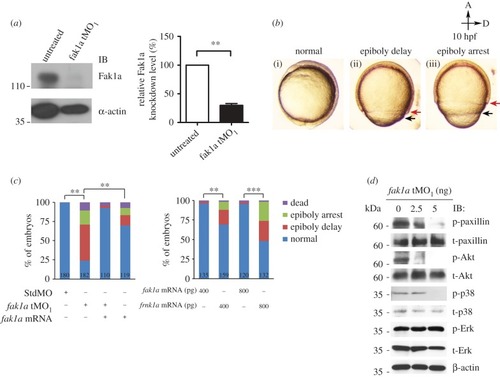
Zebrafish fak1a morphants reveal severe gastrulation defects. (a) Zebrafish embryos were treated or untreated with a fak1a translation blocking morpholino (fak1a tMO1) and immunoblotted (IB) against Fak1a and β-actin (loading control). The intensities of Fak1a bands were normalized to that of β-actin. The relative knockdown levels of Fak1a in treated embryos are shown by comparing band intensity to that of untreated embryos (right panel, n = 3; **p < 0.01). (b) The epiboly progression of fak1a tMO1-treated embryos was either delayed (ii) or arrested (iii) compared to the normal standard control MO-injected embryos (i) at 10 hpf as presented in bright-field images. Black and red arrows point to the running fronts of the enveloping layer and deep cell layer, respectively. All images have the animal pole (A) placed at the top and the dorsal to the right (D). (c) Embryos were treated as indicated and classified into different categories as indicated, and percentages of embryos in each category are shown (n = 3, **p < 0.01; ***p < 0.001). The total number of embryos used in each treatment is shown at the bottom of each bar. (d) Proteins of embryos injected with or without 2.5/5 ng fak1a tMO1 were extracted and immunoblotted using indicated antibodies. β-Actin was used as a loading control.
|

